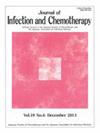Multifocal pyogenic arthritis and osteomyelitis with bacteremia caused by Streptobacillus notomytis: A case report and comprehensive literature review
IF 1.5
4区 医学
Q3 INFECTIOUS DISEASES
引用次数: 0
Abstract
Streptobacillus notomytis, recently recognized as a distinct species from Streptobacillus moniliformis—the primary causative agent of rat-bite fever—has been implicated in rare human infections. To date, there are no documented cases of femoral and tibial osteomyelitis attributable to this pathogen. Herein, we report a case of multifocal pyogenic arthritis and osteomyelitis involving the femur and tibia with bacteremia caused by S. notomytis, alongside a review of human infections associated with this organism. A 73-year-old woman initially presented with left knee pain at another hospital, where a filamentous gram-negative bacillus was isolated from joint aspirate and blood cultures. After developing sepsis, she was transferred to our facility. On admission, she had tenderness in both shoulder joints and swelling in the right fingers and wrist. Arthroscopic lavage was performed, and empirical antibiotics were initiated. Further analysis of the original isolates using matrix-assisted laser desorption ionization-time of flight mass spectrometry (MALDI-TOF MS) identified S. moniliformis with a low confidence score of 1.6. Magnetic resonance imaging confirmed osteomyelitis of the femur and tibia. After 9 weeks of targeted therapy, the patient fully recovered ambulatory function. Subsequent 16S rRNA gene sequencing definitively identified the pathogen as S. notomytis. These findings highlighted that in cases of pyogenic arthritis with unclear etiology and potential rodent exposure, Streptobacillus spp., including S. notomytis, should be considered. Comprehensive diagnostics, including 16S rRNA sequencing, are essential for accurate pathogen identification, and careful monitoring for complications like osteomyelitis is crucial during management.
非芽孢杆菌引起的多灶性化脓性关节炎和骨髓炎伴菌血症1例报告并综合文献复习。
非霉菌性链球菌,最近被认为是与念珠状链球菌不同的一种,念珠状链球菌是鼠咬热的主要病原体,它与罕见的人类感染有关。迄今为止,没有记录的病例股骨和胫骨骨髓炎可归因于这种病原体。在此,我们报告一例多灶性化脓性关节炎和骨髓炎涉及股骨和胫骨与细菌血症引起的链球菌notomytis,以及人类感染与该生物体的回顾。一名73岁妇女最初在另一家医院出现左膝疼痛,在那里从关节抽吸和血液培养中分离出一种丝状革兰氏阴性杆菌。出现败血症后,她被转移到我们这里。入院时,双肩关节有压痛,右手手指和手腕肿胀。进行关节镜灌洗,并开始使用经验性抗生素。利用基质辅助激光解吸电离飞行时间质谱(MALDI-TOF MS)对原始分离物进行进一步分析,鉴定出念珠菌,置信度为1.6。磁共振成像证实股骨和胫骨骨髓炎。经过9周的靶向治疗,患者完全恢复了行走功能。随后的16S rRNA基因测序确定该病原体为葡萄球菌。这些研究结果强调,在病因不明和可能暴露于啮齿动物的化脓性关节炎病例中,应考虑链球菌,包括nottomytis。包括16S rRNA测序在内的全面诊断对于准确鉴定病原体至关重要,在治疗过程中,仔细监测骨髓炎等并发症至关重要。
本文章由计算机程序翻译,如有差异,请以英文原文为准。
求助全文
约1分钟内获得全文
求助全文
来源期刊

Journal of Infection and Chemotherapy
INFECTIOUS DISEASES-PHARMACOLOGY & PHARMACY
CiteScore
4.10
自引率
4.50%
发文量
303
审稿时长
47 days
期刊介绍:
The Journal of Infection and Chemotherapy (JIC) — official journal of the Japanese Society of Chemotherapy and The Japanese Association for Infectious Diseases — welcomes original papers, laboratory or clinical, as well as case reports, notes, committee reports, surveillance and guidelines from all parts of the world on all aspects of chemotherapy, covering the pathogenesis, diagnosis, treatment, and control of infection, including treatment with anticancer drugs. Experimental studies on animal models and pharmacokinetics, and reports on epidemiology and clinical trials are particularly welcome.
 求助内容:
求助内容: 应助结果提醒方式:
应助结果提醒方式:


